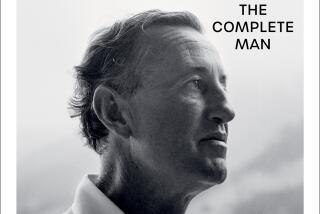A Biography That Brings Fleming In From Out of the Cold : IAN FLEMING: The Man Behind James Bond by Andrew Lycett; Turner Publishing $24.95, 486 pages
- Share via
The first glimmer of Ian Fleming’s rich life of the mind came to light when he was a young naval officer in British intelligence during World War II.
The task at hand was to capture a code book used by the German navy so that the Allies would be able to read the encrypted radio traffic between enemy ships. Fleming’s solution was to ask the Royal Air Force to secure “an air-worthy German bomber” and a German-speaking crew, crash the plane in the English Channel, and then--if and when a German air-sea rescue boat showed up--”shoot German crew, dump [them] overboard, and bring rescue boat back to English port,” hopefully with a code book aboard.
Nothing quite so daring was actually attempted, but Fleming eventually found a way to put his imagination to work, safely and profitably, when he set himself the task of writing a novel called “Casino Royale”--and, quite inadvertently, created not only a new genre of spy fiction but an institution and an industry.
Andrew Lycett, a skilled biographer whose previous work focused on Libya’s Moammar Kadafi, explains that his research into the life of Ian Fleming suggested not one but four books--”. . . a social history of the 1930s, a biography of a wartime naval intelligence officer, a love story, and a literary criticism of the Bond novels”--and he manages to work all four themes into his ambitious biography.
We follow Fleming through his unsatisfying efforts at making a living as a military officer, diplomat, journalist, banker and stockbroker, but it is not until World War II that he comes fully alive: “War . . . proved his making,” Lycett observes, “satisfying a powerful need to confirm while providing unexpected outlets for his imaginative genius.”
More often than not, Lycett finds himself debunking the more lurid myths that attached themselves to Fleming. For example, Fleming did not arrange for Rudolf Hess to make his famous flight to Scotland during World War II, nor did he play a role in the search for Nazi war criminal Martin Bormann at the end of the war. Indeed, Lycett shows us a letter in which Fleming complains of not really having much to do after the collapse of the Third Reich.
“Apart from stealing the archives of the German navy on the Czechoslovak border,” he wrote to a friend with tongue in cheek, “I have had no devilry for too long.”
Still, Fleming encountered much in the way of spy craft while serving as a desk-bound intelligence officer--gas pistols disguised as fountain pens, hollowed-out golf balls used to smuggle messages to prisoners of war, a trapdoor in the bottom of a tanker through which mini-submarines were secretly launched--and Lycett carefully tracks these artifacts into the Bond novels.
Fleming seemed to intuit what would become of the character that he created--he bought himself a special gold-plated Royal typewriter in 1952 in celebration of the completion of the very first Bond novel. “Like hashish-taking,” Fleming would later say of the decade or so of wealth and fame that he enjoyed, “it has no excuse and no end.” And he was right, of course--James Bond has survived his creator’s premature death from heart disease in 1964, and shows no signs of flagging.
Lycett demonstrates that Fleming crafted an authentic pop-culture icon when he created Agent 007--his wife, Ann, referred to him as “Thunderbeatle”--but Lycett’s biography of “the man behind James Bond” is no pop bio. Rather, it is a detailed, exacting and meticulous work of literary biography that aspires to and achieves a kind of stately grandeur even as it ponders the making of a thriller.
More to Read
Sign up for our Book Club newsletter
Get the latest news, events and more from the Los Angeles Times Book Club, and help us get L.A. reading and talking.
You may occasionally receive promotional content from the Los Angeles Times.










